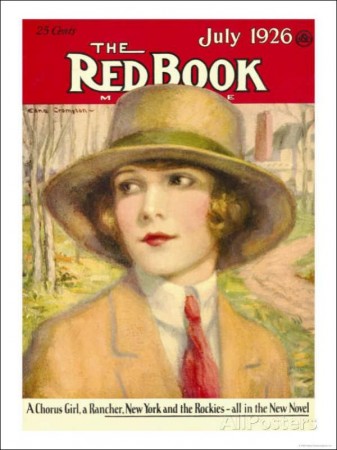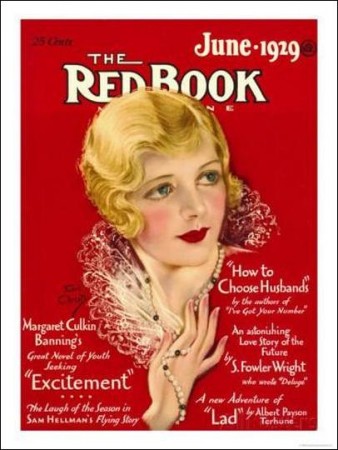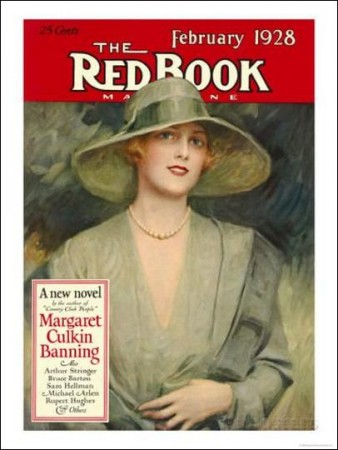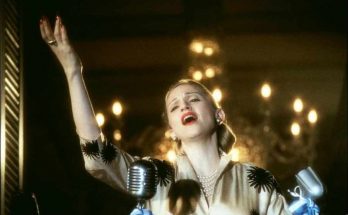Redbook is an American women’s magazine published by the Hearst Corporation. It is one of the “Seven Sisters”, a group of women’s service magazines.
The magazine was first published in May 1903 as The Red Book Illustrated by Stumer, Rosenthal and Eckstein, a firm of Chicago retail merchants. The name was changed to The Red Book Magazine shortly thereafter. Its first editor, from 1903 to 1906, was Trumbull White, who wrote that the name was appropriate because, “Red is the color of cheerfulness, of brightness, of gayety.” In its early years, the magazine published short fiction by well-known authors, including many women writers, along with photographs of popular actresses and other women of note. Within two years the magazine was a success, climbing to a circulation of 300,000.
When White left to edit Appleton’s Magazine, he was replaced by Karl Edwin Harriman, who edited The Red Book Magazine and its sister publications The Blue Book and The Green Book until 1912. Under Harriman the magazine was promoted as “the largest illustrated fiction magazine in the world” and increased its price from 10 cents to 15 cents.
According to Endres and Lueck (p. 299), “Red Book was trying to convey the message that it offered something for everyone, and, indeed, it did… There was short fiction by talented writers such as Jack London, Sinclair Lewis, Edith Wharton and Hamlin Garland. Stories were about love, crime, mystery, politics, animals, adventure and history (especially the Old West and the Civil War).”
Harriman was succeeded by Ray Long. When Long went on to edit Hearst’s Cosmopolitan in January 1918, Harriman returned as editor, bringing such coups as a series of Tarzan stories by Edgar Rice Burroughs. During this period the cover price was raised to 25 cents.
In 1927, Edwin Balmer, a short-story writer who had written for the magazine, took over as editor; in the summer of 1929 the magazine was bought by McCall Corporation, which changed the name to Redbook but kept Balmer on as editor. He published stories by such writers as Booth Tarkington and F. Scott Fitzgerald, nonfiction pieces by women such as Shirley Temple’s mother and Eleanor Roosevelt, and articles on the Wall Street Crash of 1929 by men like Cornelius Vanderbilt and Eddie Cantor, as well as a complete novel in each issue. Dashiell Hammett’s The Thin Man was published in Redbook. Balmer made it a general-interest magazine for both men and women.
Radio Broadcastings
On May 26, 1932, the publisher launched its own radio series, Redbook Magazine Radio Dramas, syndicated dramatizations of stories from the magazine. Stories were selected by Balmer, who also served as the program’s host.
Circulation hit a million in 1937, and success continued until the late 1940s, when the rise of television began to drain readers and the magazine lost touch with its demographic. In 1948 it lost $400,000 (equivalent to $3.94 million today), and the next year Balmer was replaced by Wade Hampton Nichols, who had edited various movie magazines. Phillips Wyman took over as publisher.
Nichols decided to concentrate on “young adults” between 18 and 34 and turned the magazine around. By 1950 circulation reached two million, and the following year the cover price was raised to 35 cents. It published articles on racial prejudice, the dangers of nuclear weapons, and the damage caused by McCarthyism, among other topics. In 1954, Redbook received the Benjamin Franklin Award for public service.
The next year, as the magazine was beginning to steer towards a female audience, Wyman died, and in 1958 Nichols left to edit Good Housekeeping. The new editor was Robert Stein, who continued the focus on women and featured authors such as Dr. Benjamin Spock and Margaret Mead. In 1965 he was replaced by Sey Chassler, during whose 17-year tenure circulation increased to nearly five million and the magazine earned a number of awards, including two National Magazine Awards for fiction.
His New York Times obituary says, “A strong advocate for women’s rights, Mr. Chassler started an unusual effort in 1976 that led to the simultaneous publication of articles about the proposed equal rights amendment in 36 women’s magazines. He did it again three years later with 33 magazines.” He retired in 1981 and was replaced by Anne Mollegen Smith, the first woman editor, who had been with the magazine since 1967, serving as fiction editor and managing editor.
Norton Simon Inc., which had purchased the McCall Corporation, sold Redbook to the Charter Company in 1975. In 1982, Charter sold the magazine to the Hearst Corporation, and in April 1983 Smith was fired and replaced by Annette Capone, who “de-emphasized the traditional fiction, featured more celebrity covers, and gave a lot of coverage to exercise, fitness, and nutrition.
The main focus was on the young woman who was balancing family, home, and career.” (Endres and Lueck, p. 305) After Ellen R. Levine took over as editor in 1991, even less fiction was published, and the focus was on the young mother. Levine said, “We couldn’t be the magazine we wanted to be with such a big audience, you have to lose your older readers. We did it the minute I walked in the door. It was part of the deal.”
Levine moved to Good Housekeeping in 1994, being replaced by McCall’s Kate White, who left for Cosmopolitan four years later. Succeeding editors were Lesley Jane Seymour (1998-2001), Ellen Kunes (2001-2004), and Stacy Morrison (2004-2010).
Views: 357






